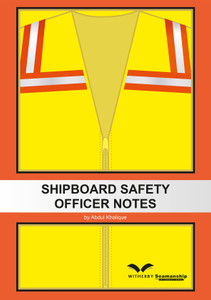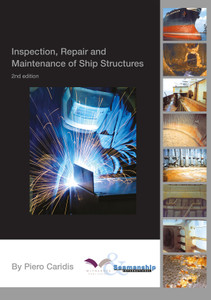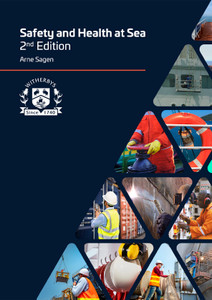
This publication is a guide to navigating and collision avoidance when sailing through a traffic separation scheme. It is useful to all deck officers learning the application of Rule 10 of the COLREGs. Accident case studies illustrate both operational and safety considerations and are visually supported by ARPA screenshots.
This
publication
offers
comprehensive
guidance
on
using
COLREGs
when
navigating
in
a
traffic
separation
scheme.
The
concept
of
a
TSS
is
explained,
in
addition
to
its
criteria
and
design
according
to
IMO
guidelines.
The
book
is
supported
by
additional
concepts,
such
as
‘hampered
vessels’,
grounding
these
in
COLREGs
guidance
and
offering
manoeuvring
advice.
The
aim
of
this
book
is
to
isolate
major
causal
factors
that,
when
followed,
break
the
‘error
chain’
and
stop
accidents
from
occurring.
Following
the
successful
introduction,
in
1967,
of
the
Dover
Strait
Traffic
Separation
Scheme
(TSS),
initially
on
a
voluntary
basis
and
later
as
a
mandatory
scheme
following
adoption
by
the
IMO
in
1971,
there
was
a
dramatic
decrease
in
the
number
of
collisions
and
near
misses
in
that
area.
Since
introducing
these
measures
there
have
been
enormous
changes
to
the
type
of
ships
transiting
the
scheme.
Ships
have
expanded
in
size
and
container
ships
of
more
than
10,000
TEU,
operating
at
speeds
greater
than
25
knots
and
with
draughts
in
excess
of
14
metres,
are
now
common.
The
dynamics
and
geometry
of
collision
avoidance
have
changed
as
these
‘gigantic
ships’
are
generating
ever
larger
interaction
forces.
In
2009,
the
United
Kingdom
and
French
governments
jointly
funded
an
investigative
study
aimed
at
‘Reducing
Risk
in
the
English
Channel’.
An
independent
team
of
consultants
attempted
to
identify
all
the
associated
causes
and
problems
that
were
contributing
to
the
perceived
increase
in
safety
risks.
This
study
was
carried
out
using
the
IMO’s
preferred
methodology
of
‘formal
safety
assessment’,
the
aim
being
to
identify
risk
mitigation
measures
that
could
be
considered
for
the
‘risk
control
options’
produced
by
the
report.
During
the
many
discussions
it
was
felt
that
most,
if
not
all,
of
the
accidents,
incidents
or
near
misses
occurred
due
to:
- A lack of knowledge, understanding, or respect for the Collision Regulations
- a lack of experience
- errors of judgement
- failure to appreciate the limitations of navigational equipment
- language or communication difficulties
- fatigue.
If
the
International
Regulations
for
Preventing
Collisions
(COLREGs)
are
adhered
to
by
ships
at
all
times,
collisions
should
be
avoidable.
In
my
own
working
life
as
a
deep
sea
pilot
in
North
West
Europe,
I
have
continually
observed
ships
blatantly
contravening
the
COLREGs
within
the
various
TSS
regions,
often
encouraging
other
ships
to
do
the
same.
While
there
are
many
reasons
for
this,
it
appears
that
there
is
an
educational
gap,
exaggerated
by
the
reduced
sea
time
requirements
for
officers
and
the
subsequent
reduced
experience
that
watchkeeping
officers
are
required
to
have.
Unfortunately,
the
demand
for
a
‘thorough
and
working’
understanding
of
the
COLREGs
appears
to
have
been
diluted.
In
reaction,
it
is
not
unusual
to
see
posters
of
light
and
signal
recognition
displayed
on
bridge
bulkheads.
Intervention
from
shore
VTS
operators
has
occasionally
added
to
the
problems
that
ships
experience.
It
is
generally
accepted
that
the
vast
majority
of
accidents
or
near
misses
are
not
the
result
of
one
factor,
but
are
due
to
an
error
chain
developing.
If
the
correct
risk
assessments
are
carried
out
and
sensible
risk
control
options
are
identified,
the
error
chain
should
be
broken.
The
aim
of
this
book
is
to
try
to
isolate
major
individual
causal
factors
that,
when
followed,
would
have
broken
the
error
chain
and
stopped
the
incident
occurring.
Section
1
Understanding
Rule
10
and
the
Need
for
TSS
Routeing
Measures
1.1
A
History
of
Ship
Routeing
and
the
Development
of
Traffic
Separation
Schemes
1.2
The
Concept
and
Application
of
Traffic
Separation
1.3
Rule
10
Traffic
Separation
Schemes
Section
2
The
Use
of
COLREGs
when
Operating
in
the
Vicinity
of
a
TSS
2.1
Approaching
and
Entering
a
TSS
2.2
Lookout
2.3
Case
Study
of
the
Grounding
of
‘LT
Cortesia’
on
the
Varne
Bank
2.4
Assessing
Risk
of
a
Collision
2.5
Case
Study
of
the
Close
Quarters
Situation
between
the
‘Costa
Atlantica’
and
the
‘Grand
Neptune’
2.6
Safe
Speed
2.7
Case
Study
–
Collision
Between
HSC
‘The
Venetian’
and
Fishing
Vessel
‘Yue
Tai
Shan
33040’
(Safe
Speed)
69
2.8
Action
by
Give
Way
Vessel
2.9
Crossing
Vessel
Encounters
within
TSS
2.10
Case
Study
‘Scot
Isles’
and
‘Wadi
Halfa’
2.11
Action
by
Stand-on
Vessel
2.12
Case
Study
of
the
Collision
between
‘Sand
Heron’
and
‘Fv
Celtit’
(Action
by
Stand-on
Vessel)
2.13
Overtaking
in
Clear
Visibility
2.14
Restricted
Visibility
2.15
Case
Study
‘Tricolor’/‘Kariba’/‘Clary’
2.16
Case
Study
‘British
Trent’
and
‘Western
Winner’
Section
3
Special
Circumstances
to
Consider
when
Transiting
a
TSS
3.1
Defensive
Navigation
3.2
Hampered
Vessels
in
a
Crossing
Situation
3.3
High
Speed
Craft
(HSC)
3.4
A
Special
Case
–
Three
Green
Lights
in
Singapore
Strait
3.5
Pilot
Boarding
Stations
Witherbys staff have significant expertise in the fields of navigation and hazardous cargoes as well as in the presentation of complex subjects in a graphic and easy to understand manner.
Captain
Kevin
Vallance
Captain Kevin Vallance has held the role of Master with South Coast Shipping Co and in 2006, became a Trinity House Licensed Deep Sea Pilot. He was elected to the United Kingdom Maritime Pilots’ Association Technical and Training Committee and represented them at a variety of safety meetings during his 5 year tenure. In 2020, he was awarded the Merchant Navy Medal for his services to maritime safety.
- Number of Pages:
- 186
- ISBN:
- 9781856096058
- Published Date:
- December 2013
- Binding Format:
- Paperback
- Book Height:
- 235 mm
- Book Width:
- 155 mm
- Weight:
- 0.7 kg
- Author:
Kevin Vallance
- Preview:
- Yes






